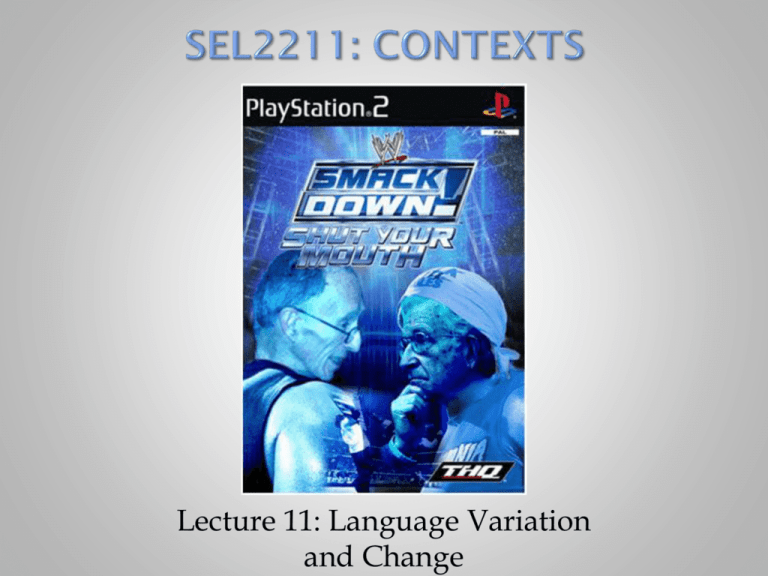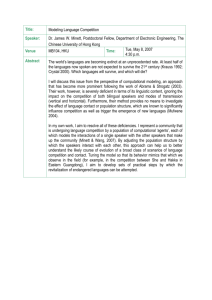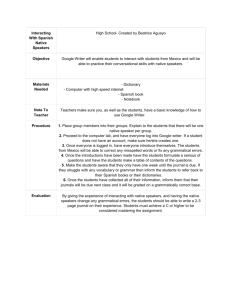Slides
advertisement

Lecture 11: Language Variation and Change Last time: The Chomskyian approach to language It’s not stimulus → response → reinforcement conditioning It’s a (non-mystical) faculty of the mind This time: Implications of this idea for two sub-fields of linguistics with a long history Puts some of these questions in a new light and forces one to think again about some traditional questions and explanations Introduction: I-language vs. E-language Chomsky – two conceptions of language I-language (‘individual’, ‘internal’, a.o.) A mental system inside an individual person’s head These individual systems are enough the same to make talking about ‘English’ or ‘Swahili’ appropriate for certain kinds of discussions (cf. ‘the human heart’) E-language (‘external’, a.o.) Out there in the word somewhere (texts/dictionaries/ grammar books, the community) Leonard Bloomfield – “the totality of utterances that can be made in a speech community” E-language assumptions v common in (nongenerative) variationist and historical contexts Some general problems/issues wrt E-language No issue of truth or falsity. Different theories/ methods for enumerating the set are equivalent. ‘Semi-grammatical’ sentences – are they in or out? If ‘in’, why aren’t they perfect? If ‘out’, why are they comprehensible? (Note: fuzzy sets aren’t the answer.) 1. Linguistic Variation On I-language conception: Nothing actually corresponds to English, Liverpool English, different varieties of Tyneside English, etc. There’s nothing but people and their brains However, for certain questions we can (and do) treat different groups as ‘the same’ (and it will vary, depending on the question). But on this view, many traditional sociolinguistic questions/investigations are irrelevant Statistical facts about populations (e.g., a group of 100 speakers drop word-final /r/ on average 45% of the time) These can’t be facts about individual speakers Or groups of speakers at some level of abstraction If you seriously want to understand this fact, probably going to end up being “the study of everything”. For Chomsky, variation is limited to parameters of UG/functional categories 2. ‘Community’ Languages Another problematic idea (One kind of) variation shows that language cannot be an individual, I-language thing Language exists independently of any particular speaker Sir Michael Dummett (1925-2011) An individual speaker has only a partial (and sometimes wrong) grasp of this ‘community language’ Why would anybody think this? A popular example: ‘elm’ vs. ‘beech’ I don’t know the difference between these, even though one exists But there are experts, dictionaries, etc. These give me information about the ‘community language’ of English that I don’t have as an individual speaker But I can be mistaken about my language, as well as ignorant What does ‘livid’ mean? Chomsky sez: none of this threatens the Ilanguage perspective People just have slightly different systems that overlap, and people defer to experts about open questions Chomsky’s heuristic: would these facts be a problem if they were about pronunciation? 3. Language Change Mark Hale (Concordia University): I-language means we need to revisit certain questions and issues in historical linguistics First what is language change? (from Hale (1998: Figure 1)) But then what about the historical record? Looks like many individual grammars share a particular innovation Only two logical possibilities: One is that a large number of speakers made identical ‘mistakes’ in acquiring their language at the same time So the same innovation independently and simultaneously arises in enough speakers to be reflected in the historical record This seems implausible The alternative: a particular change, on the part of a particular speaker, has undergone diffusion A socially prestigious speaker comes into contact with other speakers who try to acquire his/her linguistic attributes. They then in turn influence other speakers A crucial point: there aren’t any linguistic constraints on diffusion Implications for language change: certain traditional claims need to be rethought It’s incoherent to talk about ‘change in progress’ or a change that takes place over centuries (though talk to Joel) The ‘change’ happens instantaneously However, once the change happens, it’s spread could take decades or centuries, depending on innovator’s social prestige, social networks he/she is connected to, etc. Also, certain traditional explanations need to be rethought A traditional driver of change (supposedly) – simplification Latin sC- syllable clusters to Spanish esC- (e.g., sko:lam → escuela ‘school’) From E-language perspective, Latin has more complex syllable structure constraints while Spanish has simpler one This raises serious questions from I-language perspective If ‘simplicity’ considerations are relevant for acquiring an I- language, why aren’t they always operative? How could this drive language change? Same deal with ‘functional’ explanations for change (e.g., ease of articulation) Why didn’t these considerations decisively influence earlier generations of speakers? Also not clear that any general theory of functional and dysfunctional changes can be articulated (rather than identifying after the fact some change as functionally motivated). Lightfoot’s (1997) account of the loss of verbsecond in English V2: the verb follows the first constituent. (V to I to C, then movement to Spec CP) The story: Children in Yorkshire and Lincolnshire (where V2 was present) were exposed to a sufficient number of speakers of more southern varieties (which didn’t have V2), such that the total amount of V2 triggering data fell below the threshold required for children in these areas to acquire V2. So these new children developed grammars which didn’t have V2. But this story can’t be right given what we already know about I-language acquisition under conditions of non-homogeneity. Children don’t mix variations in the PLD into a hybrid which contains both. They’re just streamed independently. Consider the following two subjects, whose PLD consists of a mixture of two different systems For reference, let’s call system 1 “English” and system 2 “Spanish” Subjects like these don’t at the end of the acquisition process have one grammar which is a mixture of the two, or an X% chance of acquiring “English” vs. a Y% chance of acquiring “Spanish”. What they acquire are two grammars, one for English and one for Spanish Crucially, from the I-language perspective, there’s no distinction between different ‘languages’ and different ‘varieties’ of the same language. As expected, acquisition of different varieties results in a similar process – people are bidialectal. So, conclusion: If we’ve decided that we want to study I-languages, then we need to think very carefully about various traditional arguments and explanations in the realm of language variation and change. While some of these may be sensible/coherent if one takes an Elanguage perspective, the shift to an I-language perspective (which Chomsky suggests may be independently desirable) requires that many of them be re-examined. Consolidation (All is revealed!)





